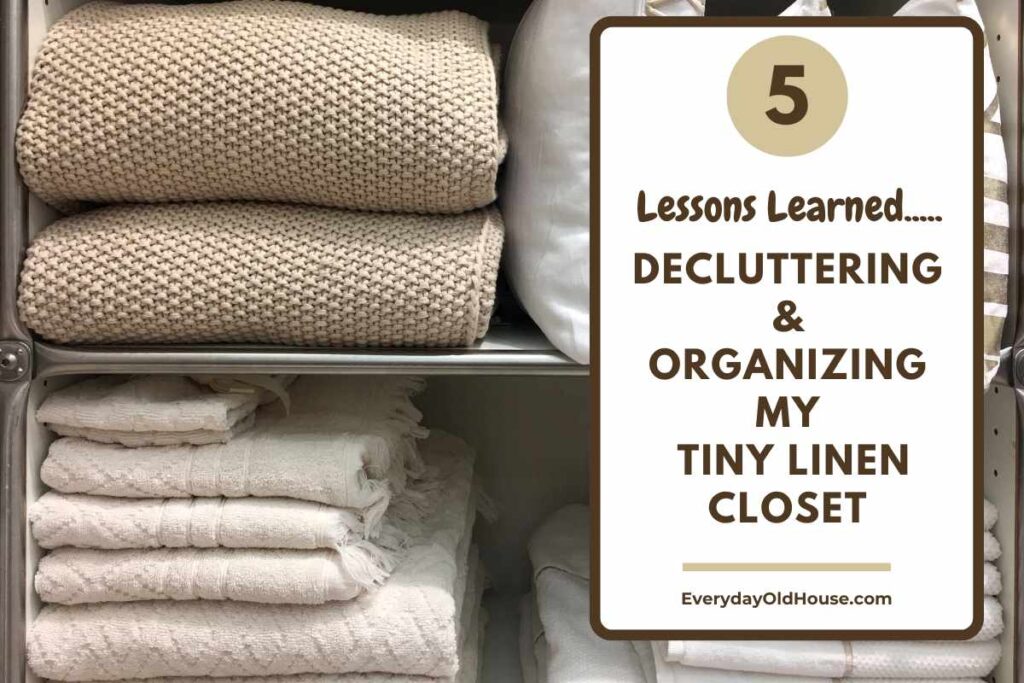Last Updated on May 16, 2024
Old homes have an undeniable charm, with architectural details and rich history, right? However, they also host a myriad of challenges when it comes to organization. But we love our old houses, so…. Here are 6 annoying organizing challenges for old houses, with practical solutions that won’t cost an arm and leg.
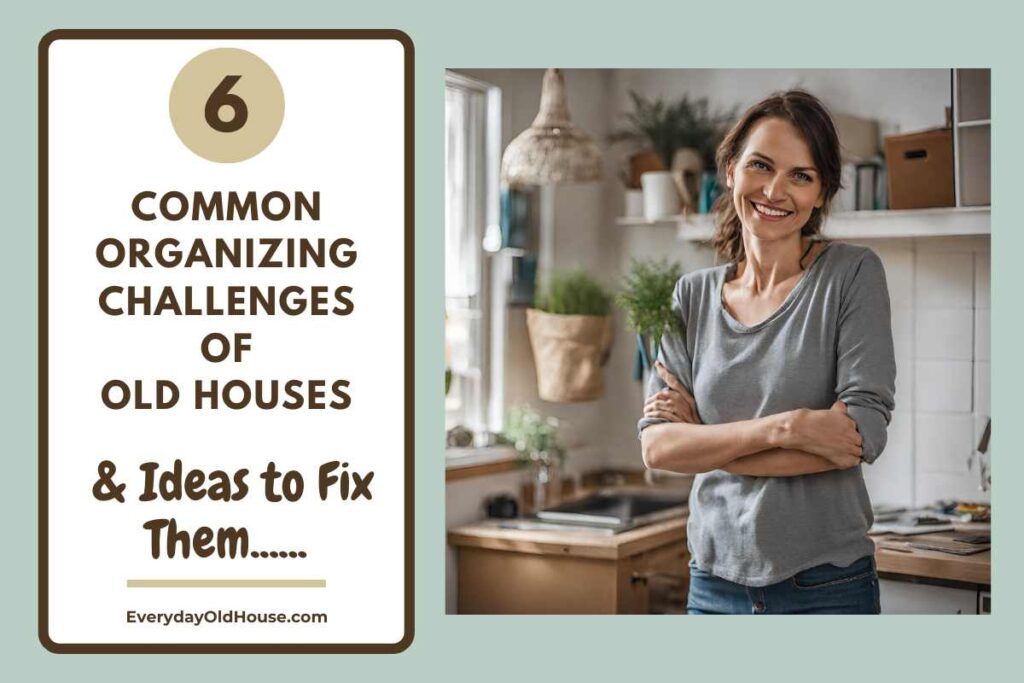
Backstory

My old house has small closets, from bedroom closets to a very narrow linen closet. Living in New England, my family members need clothes for all four seasons. From tank tops in the summer to heavy parkas and snow boots in the winter.
And quite frankly, our bedroom closets can’t hold all 4 seasons. We are lucky to get 2 seasons of clothing in our closets. The best way I’ve found to solve this problem is using the extra space in our full walk-up attic. It’s annoying, especially when we have a random 70-degree day in early April and all the shorts are in the attic. But we work with what we’ve got, right?
6 Organizing Challenges for Old Houses
While some may say the answer is an aggressive decluttering process of the entire home to rid our homes of “too much stuff”, it’s just not realistic. Our homes have insufficient storage for today’s modern living. We can’t expect our family members to become minimalists. But with some creativity, we can tackle these challenges and create an organized home even with a small space.
If you live in an older home and wonder how you’re to make it work for modern life, here’s the most common storage challenges of old homes (and more importantly, how to fix them).
- Limited Closet Space
- Irregular Room Design
- Uneven Floors
- Lack of “Modern” Rooms
- Inadequate Kitchen Cabinets
- Insufficient Electrical Plugs
By implementing a few of these solutions, you make the most of every square inch in your own home. You will probably notice some of the same solution is listed for different challenges, like “multifunctional furniture”, which can solve the problems of limited closet space, lack of “modern rooms” and insufficient electrical plugs. Kind of nice, right? As he saying goes, kill 2 birds with 1 stone?
Transform even the most cramped closet into a functional and organized space.
1. Limited Closet Space
In old houses, closets are typically smaller and fewer in number. Why? Closets in older homes were designed with a different era’s wardrobe in mind. Family members had fewer possessions.
RELATED POST: Why Do Old Houses Have Tiny Closets? A Quick History
Most older homes don’t have coat closets, walk-in bedroom closets, and hall closets. Closets might be shallow and narrow, offering little more than a single clothes rail – a far cry from the luxurious hanging space in modern homes. A cramped closet can leave us feeling like we’re constantly playing a game of Tetris with our belongings, trying to make the most of every inch of small space.
Solutions
1. Space-Saving Closet Organizers: The best way to maximize closet space? Invest in hanging shelves, over-the-door racks, and cascading hangers. These simple additions can instantly double or even triple your closet’s storage capacity.
2. Under-Bed Storage Bins: Low-profile under-bed storage bins store out-of-season clothing, extra linens, or bulky items like blankets and comforters. We have bins under my children’s beds to store toys and crafts, and under my husband and I’s bed with extra linens. These bins keep items neatly tucked away while still being easily accessible.
3. Freestanding Wardrobes or Armoires: These furniture pieces not only provide additional storage space but if you get the right style, add vintage character and charm to your home’s decor.
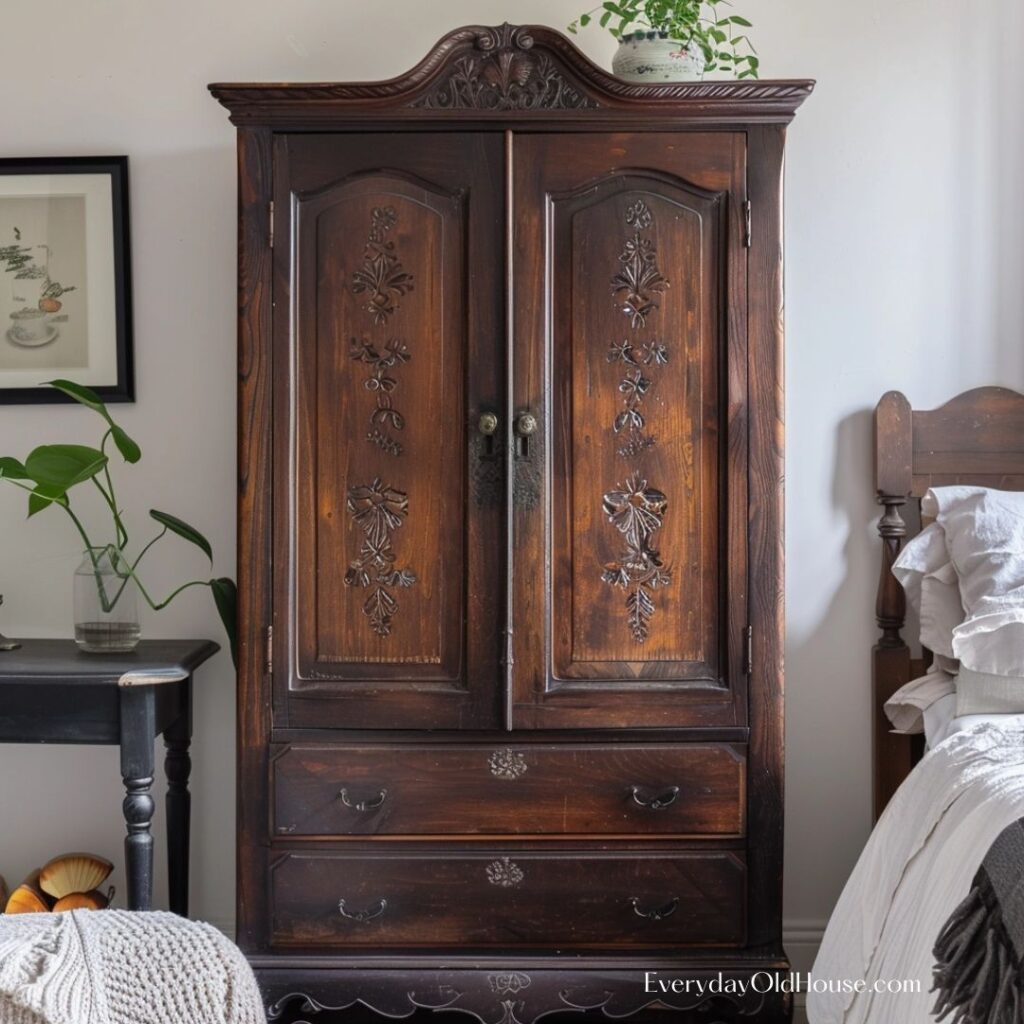
4. Multifunctional Furniture: Opt for ottomans with hidden compartments, beds with built-in drawers, or benches with storage underneath seating areas.
5. Utilize Untapped Areas: Explore storage possibilities in attics (with proper ventilation and organization) or basements (implementing solutions to address dampness). Even under-the-stairs space can be utilized with proper planning and organization.
6. Maximize Vertical Space: Install floor-to-ceiling shelves or cabinets on walls. Utilize the tops of doorways or windows for shallow storage.
2. Irregular Room Design
Another unfortunate distinctive feature of old homes is their irregular room shapes. Watch an old house show on HGTV or Magnolia and you will quickly see homes with cozy nooks to awkward alcoves. Or entire rooms with weirdly placed doors and windows. The kitchen in my husband’s old house in upstate NY (which wasn’t huge) had 7 doors along 3 walls!!! There was no wall space – an organization nightmare!
These irregular layouts can make it challenging to find furniture and storage solutions that fit seamlessly into the space without sacrificing functionality or aesthetics.
Solutions
1. Custom-Built Furniture: While not the cheapest option, custom-built furniture can be tailored to fit odd angles and corners. Maximize space efficiently while complementing the historical character of your home.
2. Modular Furniture: A great way is to get creative with modular furniture. Flexible furniture like modular sofas, bookcases, and shelving units. These can be rearranged and reconfigured to suit your changing needs and home’s quirky layout. Bonus points for slim furniture – a great way to squeeze use out of tight spaces. And don’t forget corner shelves that disguise those oddly angled walls.
3. Utilize Vertical Space: Corner shelves (and floating shelves) make use of vertical space without encroaching on valuable floor space. These shelves not only provide additional storage but also draw the eye upward. They create the illusion of height and openness in old houses with low ceilings or cramped dimensions.
4. Divide and Conquer: Don’t be afraid to use room dividers or curtains to create designated areas within a single room. This can help define different zones within the entire room (even with an open floor plan) and make it feel more organized and functional.
3. Uneven Floors
While uneven floors may seem quirky and charming, they can also make it a annoying organizing challenge for old houses (in addition to signs of structural damage). Uneven floors make furniture placement tricky as you find yourself sitting in a chair that dips or rocks. Or feeling a sense of disorientation when walking through the room.
Solutions
1. Adjustable Furniture: If buying new furniture, the best way to navigate uneven floors is to opt for furniture pieces with adjustable legs. This way you can compensate for dips or slants in the floor and ensure your furniture sits level and stable. Already own furniture? Consider adding casters or wheels to even out the dips. (Our coffee table is on casters, but that’s more for needed space when I want to work out in the living room.)
2. Rug Placement: The strategic placement of rugs can visually define different zones within a room, drawing the eye away from dips from uneven floors.
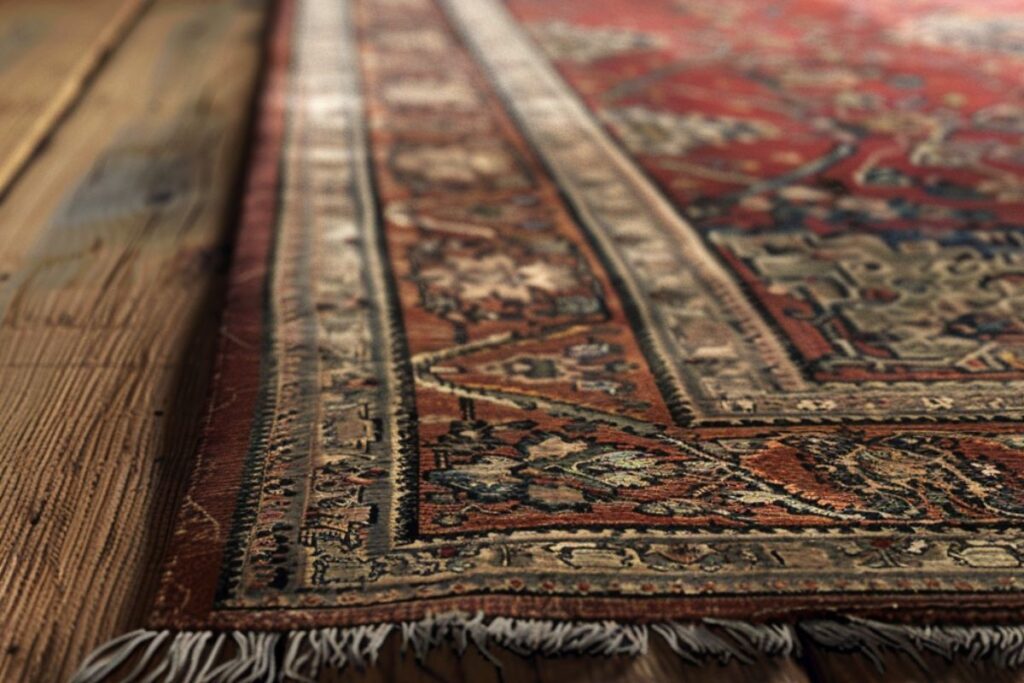
4. Lack of “Modern” Rooms
A home with a dedicated laundry room with linen closet, mudroom, and home office is now part of the fabric of modern living.. BUT these living spaces were not part of old house life. Laundry was done outside (or off-site), shoes were kicked off at the front door, and work happened at the kitchen table. But that’s not part of today’s culture for family members.
Solutions
1. Repurpose Existing Spaces: Underutilized closets or oddly shaped nooks can be transformed into functional havens. Consider converting a spare closet into a laundry nook with a stackable washer and dryer tucked neatly behind closed doors. A small room near the entrance might be the perfect candidate for a mudroom – install sturdy hooks for coats and bags, add a shoe rack or cubbies, and create a designated drop zone for backpacks and everyday essentials.
2. Get Crafty with DIY: Feeling handy? Think about tackling some DIY projects to create built-in functionality. A simple desk with shelves built against a wall can transform a corner into a dedicated workspace. Utilize creative shelving solutions, like floating shelves or hanging baskets, to define a laundry area in a shared utility room. Create your storage solutions tailored to the unique layout of your own house.
3. Multifunctional Furniture: Opt for furniture that serves multiple purposes, like a dining room table that folds into a workspace, a living room storage ottoman that provides extra seating, or a daybed with built-in drawers for blankets and linens.
5. Inadequate Kitchen Storage
Older homes often come with kitchens that were designed with different cooking and storage needs in mind. While there has always been some level of need for storage in the kitchen, kitchen cabinets as we know them weren’t even common until the early 1900s!
A small kitchen, limited cabinet storage, awkward layouts, and outdated storage solutions can make organizing a kitchen in an old house very difficult.
Solutions
1. Wall-Mounted Shelves and Pegboards: These can be used to store frequently used items like pots, pans, utensils, and spices, keeping them within easy access while freeing up valuable counter and cabinet space.
2. Space Above Cabinets: Don’t let the space above your kitchen cabinets go to waste. Use this area to store infrequently used appliances, seasonal items, or decorative pieces. Invest in decorative baskets or bins to keep items organized and visually appealing.
RELATED POST: How to Clean the Top of Kitchen Cupboards [4 Simple Steps]
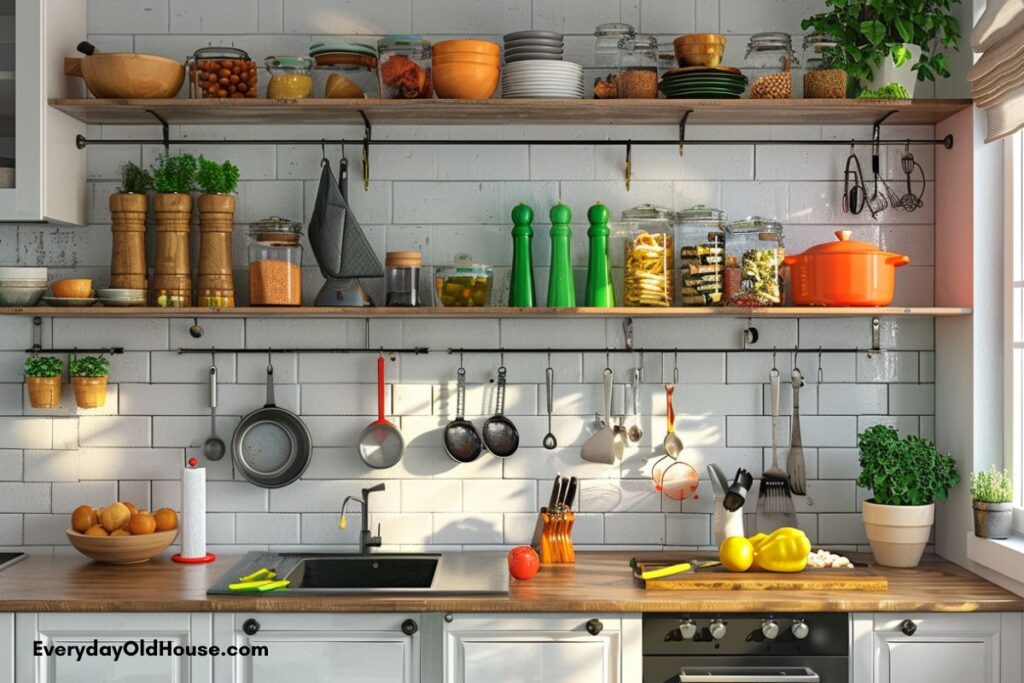
3. Stackable Containers & Drawer Dividers: These can help you efficiently store and organize everything from food items and cookware to utensils and kitchen gadgets.
Not only do storage containers and organizers create extra space, they make it easier to find what you need when you need it (even the junk drawer!).
6. Insufficient Electrical Outlets
Older homes often have fewer electrical outlets than modern houses, which can be a significant and annoying organizing challenges of old houses. It’s inconvenience in today’s technology-driven world. The scarcity of outlets can make it challenging to power multiple devices and appliances simultaneously, leading to cluttered extension cords and power strips.
Solutions
1. Install Additional Outlets: If feasible, consider hiring a qualified electrician to install additional outlets in key areas of your home. This can involve adding outlets to existing circuits or installing new circuits to accommodate the increased electrical demand.
2. Multifunctional Furniture: To reduce reliance on electrical outlets, consider investing in multi-functional furniture with built-in outlets or USB ports. We have UBS ports on our living room couch.
These pieces not only provide additional functionality but also help distribute power more evenly throughout your home, reducing the strain on existing outlets.
3. Strategic Use of Extension Cords and Power Strips: While not ideal, strategic placement of extension cords and power strips can help mitigate the issue of limited outlets.
RELATED POST: 9 Easy Solutions to Hide Electrical Cords Behind Tables and Desks
Place them strategically in areas where you frequently use electrical devices, ensuring they are safely secured and not overloaded.
In the end, organizing in an old house is not just about decluttering and tidying up (unfortunately). It’s also about getting creative and creating space that works for your family members and your home.
Related Posts
Want to be the first to know about new posts? Be sure to follow me on Pinterest, Facebook, Instagram or Twitter of even Etsy! Or better yet… Subscribe below!
My monthly (admittedly sometimes more, sometimes less….) emails are like receiving a unexpected letter from an old friend WITHOUT needing to put on your slippers and walk out to your mailbox…. See? I got ya, my friend!)
[Note: My posts are proudly connected to these amazing link parties full of DIY ideas and inspiration!]
